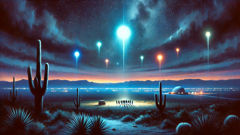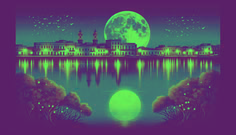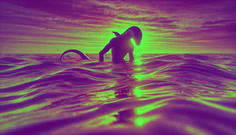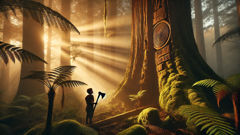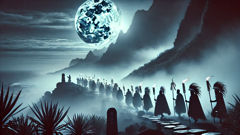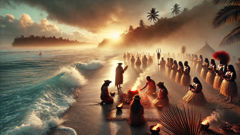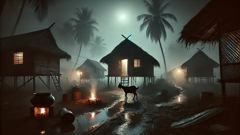Introduction
Under the vast, indigo canopy of the West Texas sky, a phenomenon dances nightly, as old as local memory and as strange as the desert itself. Here in Marfa, where the Chihuahuan Desert stretches to the horizon and the mountains rise like ancient bones, mysterious orbs of light flicker across the darkness. Some call them ghost lights, others blame atmospheric tricks, and a few whisper of visitors not of this earth. Yet for generations, these floating globes have drawn the curious, the hopeful, and the skeptical alike to the lonely Marfa plains. It’s a landscape both harsh and hauntingly beautiful: cacti bristling under moonbeams, yucca blooms shivering in the breeze, and silence as deep as the star-studded sky. The highway east of town, known to locals and travelers alike as the best place to witness the lights, becomes a silent gathering ground after sunset. Cameras flash, voices hush, and all eyes turn toward the mysterious horizon. The legend of the Marfa Lights isn’t just a tale of unexplained phenomena—it’s woven into the fabric of this place. It lingers in the old stories told around campfires, in the faded photographs pinned up in roadside diners, and in the hush that falls when the first light appears. It’s a mystery that resists explanation, inviting each new generation to seek answers in science, in superstition, and in their own hearts. Tonight, as dusk gives way to night, three travelers—each drawn by different desires—arrive in Marfa. Their paths will cross beneath the eerie glow of the lights, and in their search for truth, they’ll uncover not only the secrets of the desert, but also of themselves. For in Marfa, the unknown isn’t just a phenomenon in the sky—it’s a journey waiting in the dark.
Arrival at Dusk
The sun slipped behind the Chinati Mountains, casting long lavender shadows across the endless stretch of Highway 90. Marfa seemed to materialize out of the dust and heat, its low adobe buildings glowing faintly in the last light of day. Three strangers approached the town from different directions: Lena, a science journalist from Dallas armed with notebooks and skepticism; Victor, an aging folk musician with a battered guitar and a satchel full of stories; and Rosa, a local artist returning home after years away, her heart heavy with memories. They each had heard of the Marfa Lights in their own way—Lena through research and rumor, Victor in the rambling tales of fellow drifters, Rosa from childhood legends whispered by her grandmother. For Lena, the journey was an assignment, but it was also a test—could she debunk the lights, or would the desert’s stubborn mystery elude her? For Victor, it was nostalgia and hope; maybe the lights held answers about a friend lost long ago. Rosa was drawn by something deeper—a longing for home, for connection to the land, and perhaps for forgiveness.
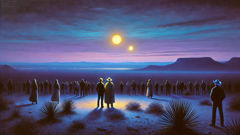
By the time Lena’s rental car pulled into the makeshift parking lot outside the Marfa Lights Viewing Area, dusk had settled like a hush over the plains. The air was sharp with the scent of creosote and distant rain. Other travelers gathered in small clusters, their silhouettes stark against the dying light. Victor arrived next, his old pickup rattling to a stop beside Lena’s compact car. He nodded to her and unpacked his guitar, strumming softly as he waited. Rosa came last, her art supplies bundled in her arms, her eyes drawn to the familiar curve of the mountains. For a while, they lingered apart, each lost in private anticipation. Then, as night deepened, a subtle change drew them together—a sudden hush, a shifting of attention to the far-off desert. There, above the scrub and mesquite, the first light appeared. It was a perfect sphere, pale gold and hovering just above the horizon. It shimmered and danced, joined soon by another—blue this time, then a third, pulsing red. Cameras clicked. Gasps and whispers traveled through the crowd. Lena frowned, already calculating possible explanations: car headlights, ball lightning, refraction. Victor watched with wide, childlike eyes. Rosa, her breath caught, remembered stories of lost souls and desert spirits. Drawn by shared wonder, they found themselves standing shoulder to shoulder. In that moment, skepticism, memory, and longing blended into something communal—a hunger for meaning in the face of the inexplicable. The lights moved in patterns no one could predict, sometimes splitting and merging, sometimes flaring bright before vanishing. Someone near them muttered, "Ghosts of the old cattle drives." Another scoffed, "Highway tricks." Rosa’s voice was barely a whisper. "My abuela said the lights were messages—from the land, from ancestors, from whatever watches over us out here." Lena glanced at her, curiosity softening her analytical gaze. Victor strummed a low, haunting chord, matching the rhythm of the lights. As the orbs drifted closer, their glow seemed to intensify, bathing the three in eerie luminescence. Shadows lengthened and blurred. In that suspended moment, time bent; the border between past and present thinned, and Marfa’s legend felt more real than any scientific explanation. When the lights finally faded, a heavy silence lingered. The crowd broke apart, but Lena, Victor, and Rosa remained, bound by the shared strangeness of what they had witnessed. "I need to know more," Lena murmured. Victor nodded. Rosa smiled, bittersweet. "Then let’s find out—together."
Whispers of History
Long after most of the crowd had left for the night, Lena, Victor, and Rosa found themselves reluctant to move. The mystery of the Marfa Lights pressed upon them, impossible to shake. As the night deepened, so did their conversation. They spoke of legends—of Apache warriors who used fire to signal across the plains, of Spanish conquistadors seeking lost cities, of railroad workers who vanished without a trace. Victor recalled a story told by his grandfather: a young vaquero, caught in a storm, lost his way and wandered into the desert, his lantern flickering in the darkness. Some claimed his spirit still searched for home, his light joining the others on lonely nights. Lena asked about scientific studies. She’d read articles—some claimed the lights were mirages, others blamed headlights refracted by temperature layers in the air. Rosa shook her head. "I’ve seen them since I was a girl. They aren’t always the same. Sometimes there are voices. Sometimes music." Intrigued, Lena suggested a deeper investigation. "Let’s talk to locals," she said. "There must be records, stories, maybe even data." Victor grinned. "We could ask at the old hotel. Folks there love to talk—especially after midnight." Rosa hesitated, then nodded. "And we should visit the ranch where my grandmother worked. She kept journals. If anyone wrote down the truth about the lights, it was her." They packed up and made their way into Marfa proper. The town was quiet, its streets empty save for the occasional coyote loping between shadows. The Hotel Paisano’s neon sign buzzed faintly above Main Street. Inside, the lobby glowed with golden lamplight and old movie posters from the filming of "Giant." The night clerk, a wiry man with tired eyes, perked up when Lena mentioned the lights. "Seen ’em all my life," he said. "My father said they only come when the desert’s ready to speak. Folks try to catch ’em on film, but it’s not always possible. Some nights, you see nothing but darkness." Victor swapped tales with the bartender—ghost stories, rumors of UFOs, tales of travelers who followed the lights and were never seen again. Rosa wandered the lobby, tracing her fingers over faded photographs of ranch hands and oil wildcatters, wondering what secrets the walls remembered. In the early hours, they left the hotel and drove toward Rosa’s childhood home—a crumbling ranch house set miles from town, its windows bright with moonlight. The road was rough and narrow, bordered by scrub and agave. At the ranch, Rosa dug through old trunks until she found her grandmother’s journals. The pages were filled with looping script and sketches of orbs, maps of where lights had appeared, even dates when unusual sounds or scents had been noted. One entry caught Lena’s eye: "Tonight, the lights danced near the old well. Heard voices—soft, like singing. Air felt different, thick with longing." Victor strummed his guitar in the quiet kitchen, picking out a melody that seemed to echo the words. Lena photographed the journals, promising to digitize them for preservation. As dawn approached, they sat on the back porch, journals spread around them, the desert silent save for distant birds. What had begun as a fleeting spectacle now felt like a living thread—woven from stories, science, memory, and hope. In the soft light of morning, Lena realized the truth was more complicated than any single explanation. The Marfa Lights were real—but their meaning changed with each person who saw them.
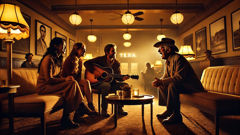
Into the Desert’s Heart
By midday, the trio was restless. The town’s stories and Rosa’s grandmother’s journals had deepened the mystery but offered no answers. Lena proposed a new approach: a scientific observation. "Let’s set up equipment near where your grandmother mapped the lights," she said. Victor and Rosa agreed, curiosity outweighing exhaustion. They gathered supplies—tripods, night-vision cameras, an electromagnetic field detector Lena had borrowed from her magazine, and Rosa’s sketchbook. Victor tuned his guitar as a charm against unease. They drove beyond the paved roads, following dirt tracks into the open range. The desert was unforgiving—prickly pear and ocotillo bristled underfoot, and wind swept fine sand into their eyes. But here, beneath a dome of flawless blue, they felt closer to the heart of the mystery. They found the old well mentioned in the journals. It was little more than a stone ring half-swallowed by earth and time. Rosa traced her fingers over the worn stones. "My grandmother said this was where the veil was thinnest." As twilight fell, they arranged their gear. Lena calibrated cameras and sensors with scientific precision. Victor built a small fire for warmth and comfort, singing quietly to the gathering dusk. Rosa opened her sketchbook and began to draw, capturing the shifting colors of sky and land. As darkness fell, anticipation grew. The wind hushed. The air grew thick with the scent of sage and wildflowers. Then, as if summoned by their presence, the lights returned—closer than before. Spheres of blue, white, and crimson glided silently over the scrub. Cameras clicked, but screens showed only blackness or faint blurs. Sensors registered strange fluctuations—pulses that rose and fell with the intensity of the lights. Victor played a slow, mournful tune, and for a moment, the orbs seemed to dance in rhythm. Rosa sketched feverishly, her lines echoing the lights’ movement. Lena watched in disbelief as scientific certainty slipped through her fingers. The lights drifted nearer until their glow enveloped the trio. Lena felt a tingling on her skin; Victor’s music faltered as emotion overcame him; Rosa heard a faint melody on the wind—a song she remembered from childhood lullabies. The air shimmered. The land seemed to breathe. Images flickered before their eyes: long-ago cattle drives, masked riders on horseback, a young woman lighting a lantern by an old well. Past and present wove together in a tapestry of memory and longing. For one brief moment, Lena glimpsed the truth—not as data or evidence, but as something larger: a living mystery that belonged to everyone who had ever stood beneath these stars. As suddenly as they appeared, the lights vanished. The spell broke. They were alone again in the silent desert, changed forever by what they’d witnessed. Lena stared at her useless cameras. "Maybe we’re not meant to explain everything," she said softly. Victor nodded, wiping a tear. Rosa closed her sketchbook, her face aglow with wonder. They knew now that the Marfa Lights weren’t just a phenomenon—they were an invitation: to seek, to remember, to believe.
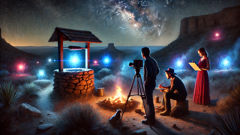
Conclusion
When dawn finally broke over the desert, painting the mesas with gold and rose, Lena, Victor, and Rosa sat in silence on the tailgate of Victor’s truck. The night’s encounter had left them awed and humbled—changed in ways they could barely describe. The data Lena collected was inconclusive; the cameras had failed to capture more than static and shadows. But each of them carried something more precious: the certainty that some mysteries are meant to endure. As the trio parted—Lena to write her article, Victor to sing new songs, Rosa to paint—the legend of the Marfa Lights became part of their own stories. They understood that the lights were not simply a puzzle to be solved, but a reminder: that there are places in this world where wonder still lives, unbound by logic or expectation. In Marfa, beneath the vast sky, mystery is not a flaw in our knowledge, but a gift—inviting us to look deeper, listen closer, and remember that sometimes, it’s enough to stand in awe beneath the stars.

